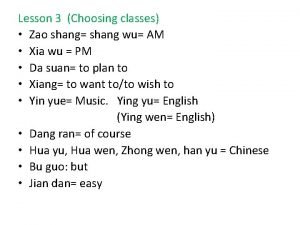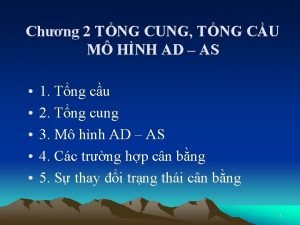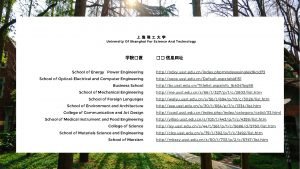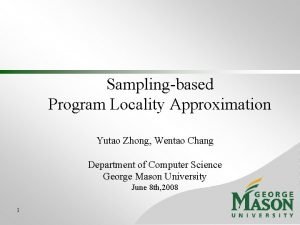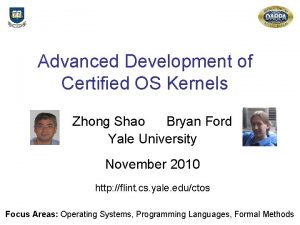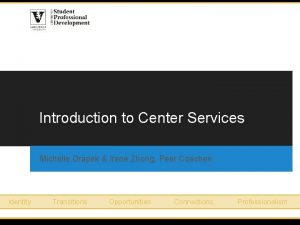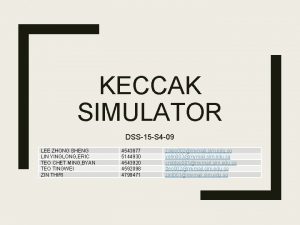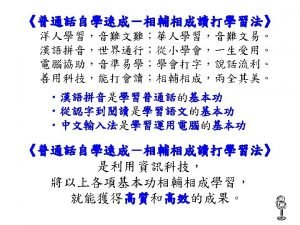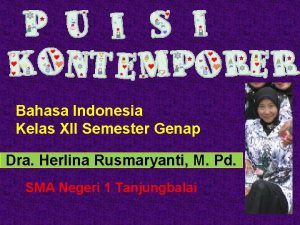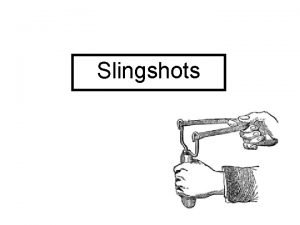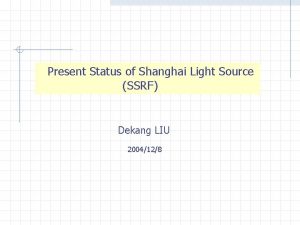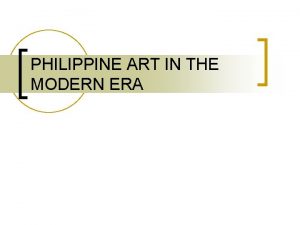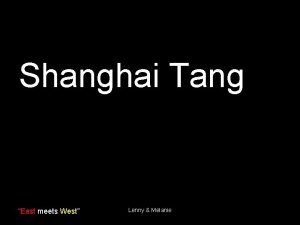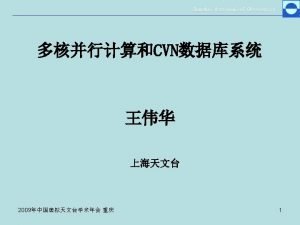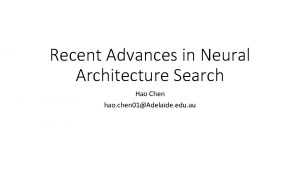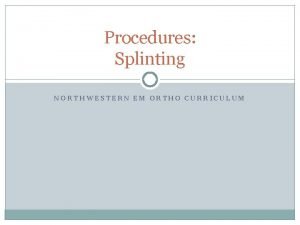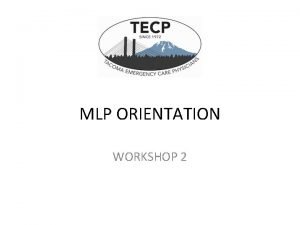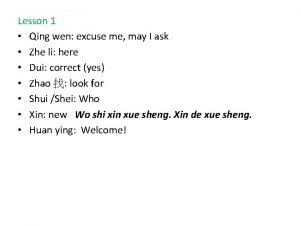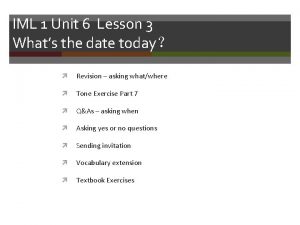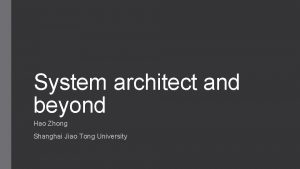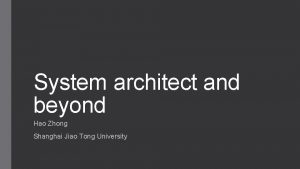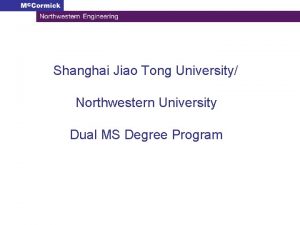Software designer Hao Zhong Shanghai Jiao Tong University





























































- Slides: 61

Software designer Hao Zhong Shanghai Jiao Tong University

Last class • Software architect Definition Typical architect styles Modularity Design decisions Tool support • Software market model • License

What is software architecture • Software architecture is the structure of a software system – like the blue prints in building architecture Software components Details (data structure and algorithms) hidden Relationships among the components Relations can be vague Data flows Control flows Dependencies

Popular architecture styles • Pipe and Filter • Layered • Repository • MVC

Why licenses? • The specialty of software, compared to other publications You often have to copy the software to use it, consider a multiple-CD/floppy disk game, hardware disposal, … Section 117 of copyright Act: the owner of a software copy have the rights to copy the software to a computer for using purpose General principle of copyrights: the owner of a copy can resell the copy without the agreement of the copyright owner: resell a book So, basically, you can copy the software from the CD to your computer, and resell the CD…

GPL (General Public License) • Most widely used license About 45% all open source projects according to Black Duck GNU software gcc, glibc, emacs, … Linux kernel My. SQL • Responsibilities Providing source code when re-distribute Re-distribute (any code including or revised from GPL licensed code) under GPL license Ignore patents and regional rules (liberty or death) • So what will happen if I want to revise a GPL-licensed software, and then sell the revised software?

Software process models Requirements engineering Design Implementation Integration The waterfall model

Role • Software design is the process by which a designer creates a specification of a software artifact, intended to accomplish goals, using a set of primitive components and subject to constraints.

Use case diagram for ATM Domain experts may not draw use case diagrams in their requirements. Software designers have to redraw use case diagrams, if software architects have changed.

Process for identifying use cases • Choose your system boundary • Identify primary actors • For each actor, find their goals • Define a use case for each goal • Decompose complex use cases into sub-use cases • Define the relations among use cases

Object-oriented approach • The runtime of software is viewed as an set of objects interacting with each other Bookstore system: books, shelves, sales clerk, client, … • Objects have data and operations Shelves: id, size, load books; clerk: name, field, sell books • A user ask an object (providing inputs) to get the information he/she wants (getting output) Ask shelves: how many books on shelves • No pre-assumed steps or sequences of execution (compared to procedureoriented approach)

Key steps in OOA • Define the domain model Find the objects, classes • Define design class diagram Find relationships between classes • Define the interaction diagrams Describe the interaction between the objects

Objects • Definition Discrete entities with well-defined boundaries Data Operations • Life Cycle Construction (new shelf bought) Running (loading books, removing books, move) Runtime state: value of mutable data in the object Destruction (shelf broken or removed)

Classes • Too many objects Cannot define one by one in the system Not general enough Consider three clerks in the bookstore (John, Mike, Nancy) • Objects share similar features can be grouped as a Class John, Mike, Nancy - > Sales Clerk Thousands of different books - > Book

UML class diagram • A diagram to describe classes and relations Core part in UML and OO approach Used as a general design document Maps to code directly in OO programming languages Modeling the system in a more visualized way

UML class diagram • Elements of class diagram: Class represented as a box containing three compartments Relation represented as a line between two classes

Class • Class represented as a box containing three compartments Name Attributes Operations • Attributes Visibility (+: public, -: private) Name (lowercase start) Type • Operations Visibility (+: public, -: private) Name (lowercase start) Parameters (name, type) Return Type

Class • Classes are named, usually, by short singular nouns • Name convention Class names start with capitalized letters Field names and method names start with lower case letters

Identifying Class • Classes are usually derived from the use cases for the scenarios currently under development • Brainstorm about all the entities that are relevant to the system

Identifying Class • Classes are entities from the problem domain Actors that interact with system. Concrete objects with some information. e. g. , Books, shelves Abstract objects. e. g. , transactions, etc. Structured Outputs. e. g. , forms, reports Helper Classes. e. g. , utility, logger, order manager, etc. • Noun Phrases Go through the use cases and find all the noun phrases Watch out for ambiguities and redundant concepts Subtypes of a class may also be a class. e. g. , customer->member

Identifying Class • Not too many Poor performance Complexity Maintenance efforts • Not too few Class too large Have a class Book. Store. Manager and do everything Uneasy to reuse Class Publisher : may be used in both book information, and order, if no such class, may have to implement twice

Class Relationships • Generalization • Aggregation • Composition • Dependency • Association

Generalization • Indicates an “is-a” relationship • All instances of the subclass are instances of the super class • A subclass inherits all attributes, operations and associations of the parent : enabling reuse • Example: Member is a customer Fruit is a Food

Generalization • Open triangle at the super class end of the association • The common attributes and operations are placed in the super class; • Subclasses extend the attributes, operations, and relations as they need them

Generalization public class Person{ String id; String name; int age; String phone. Number; String address public update. Info (String phone. Number, String adress){ … } } public class Sales. Clerk extends Person{ String field; public sell(Book book){ … } }

Aggregation • Indicates a loose “has-a” relationship • The compound class is made up of its component classes Whole can exist independently of the parts Part can exist independently of the whole • It is possible to have shared ownership of the parts by several wholes • Example: Committee : Person

Aggregation • Syntax: hollow diamond at the compound class end of the association public class Committee{ Array. List<Person> list = new Array. List<Person>(); int size; … public accpet(Person p){ if(list. size()<size) list. add(p); } }

Composition • Composition also describe “has a” relationship • Component classes are physically part of the compound class • The component class dies if the compound class dies • Example: Car : Engine

Composition • Syntax: filled diamond at the compound class end of the association public class Car{ Engine engine; … public Car(){ engine = new Engine(); } }

Composition vs. aggregation • The main difference is that: in composition, the lifecycle of components is controlled by the compounds public class Compound{ Component c; public Compound (){ this. c = new Component(); } } public class Aggregation{ Component c; public Aggregation(Component comp){ this. c = comp; } }

Dependency • A dependency is a directed relationship which is used to show that some UML element or a set of elements requires, needs or depends on other model elements for specification or implementation.

Dependency public interface Car { void run(); } public class Audi implements Car { public void run() {…} } public class Byd implements Car { public void run() {…} } public class Car. Factory { public static Car create. Car(String type){ if("奥迪". equals(type)){ return new Audi(); }else if("比亚迪". equals(type)){ return new Byd(); }else{ return null; } } }

Association • An association is a relationship between classes • An association is a name, usually short verb Some people name every association Others name associations only when such names will improve understanding e. g. , avoid names like “is related to”, and “has” • An association represents different types of relationships e. g. , student take course, book on the shelf, etc.

Association • An association may have An association name Multiplicity, Role names

Multiplicity • Multiplicities on classes indicate how many instances of the class can be associated at run time • Syntax: 1, *, etc. at the association end. Examples: * (zero or more) Person : car 1. . * (one or more) Person : address 5. . 40 (5 to 40) Students : course 5 (exactly 5) Athlete : basketball team If no multiplicity is specified, the default is 1

Role Name • Is a part of association • Describes how the object at the association end is viewed by the associated object • Is useful for specifying the context of the class • Syntax: name at the association end

Review of Class Diagram • A class defines a group of objects with same features within the context of the system • A class diagram describes classes and their relations • Identify classes Actors Concrete / Abstract objects Structured Inputs/ Outputs

Review of class diagram • Class Name, Attributes, Operators • Relations Generalization Aggregation Composition Aggregation vs. Composition Dependency Association Name, multiplicity, role name Dependency vs association

Sequence diagram • Class Diagram describes the static structure of a software • Need to know how objects will interact with each other • Sequence Diagram describes how objects talk with each other • Sequence diagram emphasizes the time-ordered sequence of messages sent and received

Sequence diagram • Column is an instance of the class Name of the instance Name of the class that the instance belongs to • Vertical dashed line is lifeline of the instance • Rectangle on life line is the focus of control (or execution), i. e. , the period during which the instance is involved in the activity initiated at the top of the focus

Sequence diagram • Horizontal arrow expresses messages conveyed by source instance to target instance • Messages may carry parameters: msg (par 1, …) • Looping arrow shows self-delegation: a lifeline sends a message to itself

Sequence diagram • Why use objects instead of classes? Class is a static concept Only objects have life cycles Objects of same class may interact

Sequence Diagram – An Example

Sequence diagram – advanced features • Use Combined Fragments, which consists of a region of a sequence diagram, to represent Branching: operator “alt” Loop: operator “loop” Assertion: operator “assert’’

The principles of object-oriented design • SRP,Single Responsibility Principle • LSP, Liskov Substitution Principle • ISP,The Interface Segregation Principle • OCP,Open-Closed Principle

SRP: The Single – Responsibility Principle • A Class should have only single responsibility • Example: • The rectangle class has two responsibilities • This design violates the SRP.

SRP: The Single – Responsibility Principle • Separating Coupled Responsibilities

LSP: The Liskov Substitution Principle • Subtypes must be substitutable for their base types • If for each object o 1 of type S there is an object o 2 of type T such that for all programs P defined in terms of T, the behavior of P is unchanged when o 1 is substituted for o 2 then S is a subtype of T [Liskov 88]. • If using implementation of T or subclass of T to instead of T, Software P which is associated with type T(interface or abstract class) can work well. • Example: In real world , penguin and bird is a “is-a” relationship. If we design penguin is a subclass of bird class , we violate LSP principle. because bird can fly( ) while penguin can not fly. So how to change this design?

ISP: The Interface Segregation Principle • It is not suggested to extend interfaces. • Example

ISP: The Interface Segregation Principle

OCP: The Open-Closed Principle • Modules should be both open (for extension; adaptable) and closed (the module is closed to modification in ways that affect clients). • In OCP, "module" includes all discrete software elements, including methods, classes, subsystems, applications, and so forth • Example

Architecture vs software engineering

Architecture

Software engineering • The technical decisions of choosing a specific framework, language, or library can have significant impacts on your designs. • Even the changes in a specific framework, language, or library can have nontrivial impacts on your designs. • However, most books teach that you shall ignore such issues. • Requirements can change after you design a software, but sometime you do not have time to update your designs.

Designing a software is not easy • Some companies only design software, but outsourcing its implementations to other companies. • It needs much experience to write a feasible software design. • Many programmers do not implement code strictly according to designs, since it is impractical to respect some design details. • Some programmers read designs as detailed requirements.

Design vs implementation • Automation Bidirectional transformation http: //green. sourceforge. net/builds. html • How any specific source language construct should be represented in UML is not strictly defined. Some mappings are not one-to-one. Some code usages are not defined. By their nature, an implementation has more details than its design.

State of the art JBOO

This class • Software designer • UML Use case diagram Identification of use cases Object oriented approach for design Class diagram Legend Class Relationships Sequence diagram • The Principles of Object-Oriented Design

Key steps in OOA • Define the domain model Find the objects, classes • Define design class diagram Find relationships between classes • Define the interaction diagrams Describe the interaction between the objects

Class Relationships • Generalization • Aggregation • Composition • Dependency • Association

Next class • Programmer
 Wo jiao
Wo jiao Shang wu
Shang wu Hao zhong
Hao zhong Hao zhong
Hao zhong Mô hình tổng cung tổng cầu
Mô hình tổng cung tổng cầu The university of shanghai for science and technology
The university of shanghai for science and technology Shanghai university of sports
Shanghai university of sports Lai ba ying ye zhong
Lai ba ying ye zhong Yutao zhong
Yutao zhong Zhong han liang
Zhong han liang Zhong shao
Zhong shao Irene zhong
Irene zhong David lagakos
David lagakos Lee zhong sheng
Lee zhong sheng 李小明
李小明 Gmc software ag
Gmc software ag Aquarium design software
Aquarium design software Pu tao you
Pu tao you Welcome in mandarin
Welcome in mandarin Open infrastructure summit 2019
Open infrastructure summit 2019 Tour eiffel tours petronas shanghai world financial
Tour eiffel tours petronas shanghai world financial Zip shanghai
Zip shanghai Puisi kawin dan winka
Puisi kawin dan winka How to make a shanghai slingshot
How to make a shanghai slingshot Huopin
Huopin Ssrf
Ssrf Modern era arts in the philippines
Modern era arts in the philippines Cityshop products
Cityshop products Melanie tang
Melanie tang Shanghai
Shanghai Kampasu
Kampasu Accenture portsl
Accenture portsl Fishing in shanghai
Fishing in shanghai Subway quality control
Subway quality control Bloomberg academy hong kong
Bloomberg academy hong kong Habiter le littoral industrialo-portuaire de shanghai
Habiter le littoral industrialo-portuaire de shanghai Shanghai
Shanghai Shanghai integrated circuit industry
Shanghai integrated circuit industry Hong kong and shanghai banking corporation ap world history
Hong kong and shanghai banking corporation ap world history Shanghai tianqi
Shanghai tianqi Ppaop
Ppaop Shanghai technology innovation center
Shanghai technology innovation center Yan oi tong tin ka ping secondary school
Yan oi tong tin ka ping secondary school Mdm teresa liew sin tong
Mdm teresa liew sin tong Lang tong explained
Lang tong explained Proxyless nas
Proxyless nas Posterior ankle splint with stirrup
Posterior ankle splint with stirrup Pei tong primary school review
Pei tong primary school review Ulnar gutter
Ulnar gutter Little britain fish and chips
Little britain fish and chips Ni hao ma
Ni hao ma Lsu orthopedics
Lsu orthopedics Lang tong
Lang tong She stood on the balcony tongue twister
She stood on the balcony tongue twister Axit fomic
Axit fomic Tong twisters
Tong twisters Hao chinese character
Hao chinese character Daniel hao
Daniel hao Fox
Fox Zao shang hao response
Zao shang hao response Xiage yue
Xiage yue Chenning tong
Chenning tong

